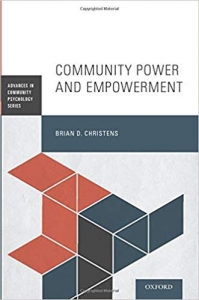In Community Power and Empowerment, Brian D. Christens provides a comprehensive and insightful examination of empowerment and of how best to use social power in order to effectively promote transformative and sustained change for equity and social justice purposes. Students, scholars, community leaders and activists, among others, will benefit from this inspiring and thoughtful work, writes Jennifer Schneider.
Community Power and Empowerment. Brian D. Christens. Oxford University Press. 2019.
Never doubt that a small group of thoughtful, committed, citizens can change the world. Indeed, it is the only thing that ever has (Margaret Mead)
It’s rare to find anyone who questions the need for change in some context – local, organisational, community, global or otherwise. A persistent challenge, though, rests in how to successfully achieve, and sustain, desired changes, whether through policies, procedures or systems. In Community Power and Empowerment, Brian D. Christens provides a comprehensive and insightful examination of empowerment and of how best to use social power in order to effectively promote transformative and sustained change for equity and social justice purposes.
Community Power and Empowerment is part of the Society for Community Research and Action (SCRA)’s Advances in Community Psychology Series, which aims to share research, relevant theory and examples of social and community action that highlight contributions to the field and identify opportunities for ongoing research. Community Power and Empowerment fulfils the series’ mission well by offering keen insights and tools that promote both dialogue and action in response to the challenge of converting social power into social justice.
Christens shares a historical overview of power and presents empowerment as a multilevel construct with interrelated layers of analysis (including psychological, organisational and community). Readers embark upon a journey that furthers the methodological and conceptual integration of, and appreciation for, community power and empowerment. Anyone hoping to bring about change in their own work and organisations, irrespective of background or focus, will find the text a valuable resource. The book not only highlights longstanding misconceptions and ambiguities associated with community power and empowerment, but also offers practical and constructive guidance for researchers, leaders and organisers seeking more effective community-driven change.
The book offers a collection of best practices based on well-documented empirical research as well as relevant field experiences, including the dynamic example of the Philadelphia Student Union (a youth-led, student-driven change effort that was founded in 1995 with a mission focused on improving the quality of education in Philadelphia public schools), to explore how community-driven systems change can be analysed through the lens of an integrated model of empowerment. The Introduction, in which the author reflects on experiences during the ‘Wisconsin Uprising’ and budget disputes at the University of Wisconsin throughout the winter of 2011, presents a call to action and an overview of mounting societal challenges that present on a daily basis.
The remainder of the work is divided into three sections. Section One focuses on conceptual histories of community power and empowerment, while Section Two constructs an ecological model of empowerment with an emphasis on empowerment processes. Section Three turns to outcomes and explores recommendations for future research. Here, Christens reminds readers that, in addition to ‘conceptual consensus’ and ‘methodological innovation’, additional work needs to be done in order to develop the fundamental research skills, design capabilities and evaluation techniques of community researchers to bring rich ‘contextually sensitive design’ and ‘multilevel research’ to fruition (195).
In Section One, Christens documents and analyses, with breadth and depth, the varied ways in which a multidimensional framework of power in community decision-making can be both ‘updated and augmented to provide a contemporary conception of community power on which we can base considerations of empowerment’ (15). For Christens, community power refers to and encompasses ‘the social and structural relationships among local residents and organizations that shape outcomes when disputes or competition for resources might arise’ (13). Christens traces the social and political nature of community power (defined in ways that are broadly applicable to anyone who lives and works in a community context amidst limited resources) and explores how to better understand community power so as to better understand and encourage empowerment.
Moving effortlessly between theory and practice with a consistent emphasis on the power of organisational learning, Christens explores theoretical frameworks and research from the social sciences to convey and illustrate ways of understanding contemporary communities’ power structures (39). Christens also emphasises throughout the relevance of globalisation in ‘an era of global capitalism’ with ‘a new power elite with global reach’ as well as marginalisation and exclusion, including steadily increasing economic inequalities (39). In the face of global capitalism and the reductions in autonomy and decision-making experienced by many local communities, the challenges faced by changemakers become even more pronounced. Related efforts to explore social power as dynamic and dependent upon collective action and democratic theory help formulate ‘a framework for community power that can account for the multiple dimensions of domination and oppression while also allowing possibilities for agency, development, and transformation’ (40).
Chapter Three is perhaps the text’s most memorable and immediately relevant chapter as it highlights and dispels widespread and longstanding misunderstandings of the term ‘empowerment’. Christens presents a historical overview of the term’s multidisciplinary, oversimplified and inconsistent usages (and misuses), cautioning readers against ambiguous interpretations, carefree (and careless) applications and co-optations of the term. As an example, Christens highlights inconsistencies in the term’s usage that imply an individualistic meaning or application. Other risks include confusion, ambiguity for practitioners and their adopted roles, compromised links between power and associated conceptions of empowerment and misdirected responses to pervasive inequalities. Christens describes empowerment as ‘a symbolic ideology that seeks to address inequities’ (61) and simultaneously notes the practical and very real potential for successful empowerment processes to address social inequalities, power relationships and associated distributions of resources.
This chapter prompts valuable self-reflection from which all interested changemakers and community organisers can benefit. Thought-provoking questions emerge: how often have I used the term ‘empowerment’ without truly understanding its meaning? How often have I seen the concept mentioned colloquially in blogs, advertisements, professional development sessions, university lectures, promotional health initiatives and community meetings? Most certainly monthly, if not weekly. How often has the term been defined and contextualised before use? Rarely, if at all. By emphasising the importance of clarity in language usage when discussing empowerment, Christens prompts all readers to do better in daily interactions, applied efforts and related research endeavours.
In Chapters Four through Six, Christens investigates empowerment at the psychological, organisational and community levels, with an emphasis on empowerment processes (distinct from outcomes). Christens presents a framework for organisational empowerment that draws upon both organisational characteristics and inter-organisational efforts with potential for positive impact. Chapter Six’s focus on what it means to be a part of a community (and the term’s ‘variety of connotations’) is valuable in that, like elsewhere in the work, he provides helpful clarifications and reminders involving term specificity and usage. One example includes the distinctions and similarities between collective efficacy and community empowerment – with collective efficacy focusing narrowly on neighbourhoods and community empowerment processes extending beyond the bounds of a neighbourhood level. Christens also highlights gaps in research: for example, a need for less emphasis on the psychological dynamics of empowerment and more formal studies of community empowerment processes.
Ultimately, Christens draws together various threads to demonstrate the need for a linked, holistic approach to empowerment, community power and change. Christens closes with a focus on outcomes and an associated emphasis on the need for creative design. Chapter Eight shares specific recommendations (referred to intentionally as design principles) that support and encourage praxis and related action plans, research and empowerment processes. Examples include the building of a wide variety of organisations that serve as social anchors and ‘building blocks for empowerment processes’ and where members have a sense of collective ownership (184), as well as an emphasis on imagination where those seeking change ‘resist confusing the status quo with the natural or inevitable’ (192).
The guiding words of ‘be the change you wish to see in the world’ are often attributed to Mahatma Gandhi. In Community Power and Empowerment, Christens presents changemakers everywhere with new ways of thinking about and approaching desired change. In doing so, Christens maintains a reflexive approach that explores the interrelationship of power and empowerment, noting that while in the pursuit of social justice demanding ever-increasing empowerment is insufficient, it is also ‘imperative to pursue empowerment in response to systematic injustices, stark and worsening inequality, and the associated concentration of power’ (61). Christens’s writing takes on a relentlessly optimistic and forward-focused tone. While acknowledging challenges, Christens simultaneously and effectively instills hope for future progress. Students, scholars, researchers, community leaders, organisers, change agents, strategists, organisation participants, practitioners and activists of all backgrounds, disciplines and interests will benefit from this inspiring and thoughtful work. The communities they serve will benefit as well.
Note: This review gives the views of the author, and not the position of the LSE Review of Books blog, or of the London School of Economics.
Image Credit: (Stephanie Graves CC BY NC SA 2.0).


 Find this book:
Find this book: 






1 Comments